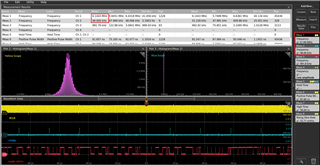Other Parts Discussed in Thread: TAS6424
Hello Team.
I would like to know about the difference between DSP mode and I2S mode in TDM case.
Currently, when I play a 48KHz/16bit/8ch with DSP mode, I am listening to the noise only.
But when I change INPUT FORMAT of SAP Control Register(0x03) from DSP mode to I2S mode, I can listen to it well.
So, I'm wondering what the difference is between them.
When I take a look at Figure19. TDM8 Audio Data Format(tas6424l-q1.pdf), I can see how i2s/left justified mode works.
But I can't see any DSP mode figure in this Figure.
Could you let me know what DSP mode is and explain me how to work based on Figure 19. TDM8 Audio Data Format?
Thank you and Regards,
KW
======================================================
root@euto-v9-discovery:~# i2cdump -f -y 27 0x6a
No size specified (using byte-data access)
0 1 2 3 4 5 6 7 8 9 a b c d e f 0123456789abcdef
00: 0f 32 62 56 00 8f 8f 8f 8f 01 01 01 00 00 00 00 ?2bV.???????....
10: 00 10 00 00 00 00 00 00 00 00 00 00 00 00 00 00 .?..............
20: 00 00 01 14 00 00 40 21 0a 00 00 00 00 00 00 00 ..??..@!?.......
30: 00 00 00 00 00 00 00 00 00 00 00 00 00 00 00 00 ................
40: 00 00 00 00 00 00 00 00 00 00 00 00 00 00 00 00 ................
50: 00 00 00 aa 00 00 00 00 00 00 00 12 32 f2 00 00 ...?.......?2?..
60: 00 00 00 00 00 00 00 00 00 00 00 00 00 00 00 00 ................
70: 00 00 00 00 00 00 00 00 00 00 00 00 00 00 00 00 ................
80: 00 00 00 00 00 00 00 00 00 00 00 00 00 00 00 00 ................
90: 00 00 00 00 00 00 00 00 00 00 00 00 00 00 00 00 ................
a0: 00 00 00 00 00 00 00 00 00 00 00 00 00 00 00 00 ................
b0: 00 00 00 00 00 00 00 00 00 00 00 00 00 00 00 00 ................
c0: 00 00 00 00 00 00 00 00 00 00 00 00 00 00 00 00 ................
d0: 00 00 00 00 00 00 00 00 00 00 00 00 00 00 00 00 ................
e0: 00 00 00 00 00 00 00 00 00 00 00 00 00 00 00 00 ................
f0: 00 00 00 00 00 00 00 00 00 00 00 00 00 00 00 00 ................


